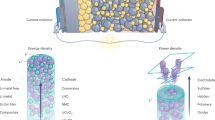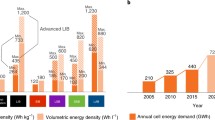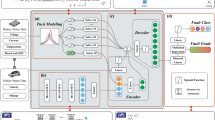Abstract
Owing to increasing demand for low-cost energy storage with secure material supply chains, the battery community is approaching a pivotal shift beyond conventional lithium-ion (Li-ion) towards next-generation cells. Technologies that include alkali-metal anodes, solid electrolytes and earth-abundant materials such as sodium (Na) and sulfur (S) are reaching commercialization in cells. The abuse tolerance and thermal runaway hazards of such technologies diverge from conventional Li-ion cells. Consequently, designing safe batteries with next-generation materials requires a holistic approach to characterize cells and to understand their responses to abuse conditions from the beginning to the end of life. Here we provide a Perspective on how the safety and abuse tolerance of cells are likely to change for up-and-coming technologies; challenges and opportunities for reimagining safe cell and battery designs; gaps in our knowledge; capabilities for understanding the hazards of thermal runaway and how to address them; how standard abuse tests may need to adapt to new challenges; and how research needs to support affected professionals, from pack designers to first responders, to manage hazards and ensure safe roll-out of next-generation cells into applications like electric vehicles (EVs). Finally, given the large number of next-generation technologies being explored, we encourage giving priority to safety-focused research in proportion to the rate of manufacturing scale-up of each specific technology.
This is a preview of subscription content, access via your institution
Access options
Access Nature and 54 other Nature Portfolio journals
Get Nature+, our best-value online-access subscription
$32.99 / 30 days
cancel any time
Subscribe to this journal
Receive 51 print issues and online access
$199.00 per year
only $3.90 per issue
Buy this article
- Purchase on SpringerLink
- Instant access to full article PDF
Prices may be subject to local taxes which are calculated during checkout




Similar content being viewed by others
References
Xu, C. et al. Future material demand for automotive lithium-based batteries. Commun. Mater. 1, 99 (2020).
Li, Z. et al. Revealing the thermal safety of Prussian blue cathode for safer nonaqueous batteries. Adv. Energy Mater. 11, 2101764 (2021).
Lee, J., Lee, T., Char, K., Kim, K. J. & Choi, J. W. Issues and advances in scaling up sulfide-based all-solid-state batteries. Acc. Chem. Res. 54, 3390–3402 (2021).
Wang, C. et al. All-solid-state lithium batteries enabled by sulfide electrolytes: from fundamental research to practical engineering design. Energy Environ. Sci. 14, 2577–2619 (2021).
Darmet, N., Charbonnel, J., Reytier, M., Broche, L. & Vincent, R. First experimental assessment of all-solid-state battery thermal runaway propagation in a battery pack. ACS Appl. Energy Mater. 7, 4365–4375 (2024).
Charbonnel, J. et al. Preliminary study of all-solid-state batteries: evaluation of blast formation during the thermal runaway. iScience 26, 108078 (2023).
Kim, T. et al. Thermal runaway behavior of Li6PS5Cl solid electrolytes for LiNi0.8Co0.1Mn0.1O2 and LiFePO4 in all-solid-state batteries. Chem. Mater. 34, 9159–9171 (2022).
Duh, Y.-S., Theng, J.-H., Chen, C.-C. & Kao, C.-S. Comparative study on thermal runaway of commercial 14500, 18650 and 26650 LiFePO4 batteries used in electric vehicles. J. Energy Storage 31, 101580 (2020).
Zhang, S. et al. Room-temperature, high-voltage solid-state lithium battery with composite solid polymer electrolyte with in-situ thermal safety study. Chem. Eng. J. 400, 125996 (2020).
Zeng, Z. et al. A safer sodium-ion battery based on nonflammable organic phosphate electrolyte. Adv. Sci. 3, 1600066 (2016).
Gribble, D. A. et al. Mechanistic elucidation of electronically conductive PEDOT:PSS tailored binder for a potassium-ion battery graphite anode: electrochemical, mechanical, and thermal safety aspects. Adv. Energy Mater. 12, 2103439 (2022).
Yang, H., Zhuang, G. V. & Ross, P. N. Thermal stability of LiPF6 salt and Li-ion battery electrolytes containing LiPF6. J. Power Sources 161, 573–579 (2006).
Wu, Y., Wang, S., Li, H., Chen, L. & Wu, F. Progress in thermal stability of all-solid-state-Li-ion-batteries. InfoMat 3, 827–853 (2021).
Wang, J. et al. Advances in thermal-related analysis techniques for solid-state lithium batteries. InfoMat 5, e12401 (2023).
Adams, R. A., Varma, A. & Pol, V. G. Mechanistic elucidation of thermal runaway in potassium-ion batteries. J. Power Sources 375, 131–137 (2018).
Charbonnel, J. et al. Safety evaluation of all-solid-state batteries: an innovative methodology using in situ synchrotron X-ray radiography. ACS Appl. Energy Mater. 5, 10862–10871 (2022).
Ohneseit, S. et al. Thermal and mechanical safety assessment of type 21700 lithium-ion batteries with NMC, NCA and LFP cathodes–investigation of cell abuse by means of accelerating rate calorimetry (ARC). Batteries 9, 237 (2023).
Bugryniec, P. J. et al. Review of gas emissions from lithium-ion battery thermal runaway failure — considering toxic and flammable compounds. J. Energy Storage 87, 111288 (2024).
Lin, L. & Ezekoye, O. A. Time-resolved characterization of toxic and flammable gases during venting of Li-ion cylindrical cells with current interrupt devices. J. Loss Prev. Process Ind. 94, 105488 (2025).
Liu, T., Kum, L. W., Singh, D. K. & Kumar, J. Thermal, electrical, and environmental safeties of sulfide electrolyte-based all-solid-state Li-ion batteries. ACS Omega 8, 12411–12417 (2023).
Park, S. S. et al. Solid electrolyte: strategies to address the safety of all solid-state batteries. Adv. Energy Sustain. Res. 4, 2300074 (2023).
Wang, S. et al. Thermal stability between sulfide solid electrolytes and oxide cathode. ACS Nano 16, 16158–16176 (2022).
Sun, S. & Xu, J. Safety behaviors and degradation mechanisms of aged batteries: a review. Energy Mater. Devices 2, 9370048 (2024).
Yan, P. et al. Intragranular cracking as a critical barrier for high-voltage usage of layer-structured cathode for lithium-ion batteries. Nat. Commun. 8, 14101 (2017).
Heenan, T. M. M. et al. Identifying the origins of microstructural defects such as cracking within Ni-rich NMC811 cathode particles for lithium-ion batteries. Adv. Energy Mater. 10, 2002655 (2020).
Sadd, M., Xiong, S., Bowen, J. R., Marone, F. & Matic, A. Investigating microstructure evolution of lithium metal during plating and stripping via operando X-ray tomographic microscopy. Nat. Commun. 14, 854 (2023).
Börner, M. et al. Correlation of aging and thermal stability of commercial 18650-type lithium ion batteries. J. Power Sources 342, 382–392 (2017).
Li, S. et al. Constant-rate heating-induced thermal runaway in 18650-type Li-ion cells charged/discharged at 1 °C: effect of undischargeable Li at anode. J. Power Sources 505, 230082 (2021).
Gabryelczyk, A., Ivanov, S., Bund, A. & Lota, G. Corrosion of aluminium current collector in lithium-ion batteries: a review. J. Energy Storage 43, 103226 (2021).
Ma, T. et al. Revisiting the corrosion of the aluminum current collector in lithium-ion batteries. J. Phys. Chem. Lett. 8, 1072–1077 (2017).
Waldmann, T. et al. Electrochemical, post-mortem, and ARC analysis of Li-ion cell safety in second-life applications. J. Electrochem. Soc. 164, A3154 (2017). This paper pioneeringly demonstrates that the safety of aged cells is strongly correlated with the dominant ageing mechanism.
Preger, Y., Torres-Castro, L., Rauhala, T. & Jeevarajan, J. Perspective—On the safety of aged lithium-ion batteries. J. Electrochem. Soc. 169, 030507 (2022).
Zhang, X., Zhu, J. & Sahraei, E. Degradation of battery separators under charge–discharge cycles. RSC Adv. 7, 56099–56107 (2017).
Ning, Z. et al. Visualizing plating-induced cracking in lithium-anode solid-electrolyte cells. Nat. Mater. 20, 1121–1129 (2021).
Liang, Z. et al. Understanding the failure process of sulfide-based all-solid-state lithium batteries via operando nuclear magnetic resonance spectroscopy. Nat. Commun. 14, 259 (2023).
Jiang, F.-N. et al. Higher-order polysulfides induced thermal runaway for 1.0 Ah lithium sulfur pouch cells. Particuology 79, 10–17 (2023).
Xiang, Y. et al. Advanced separators for lithium‐ion and lithium–sulfur batteries: a review of recent progress. ChemSusChem 9, 3023–3039 (2016).
Roth, E. P., Doughty, D. H. & Pile, D. L. Effects of separator breakdown on abuse response of 18650 Li-ion cells. J. Power Sources 174, 579–583 (2007).
Zhao, Q., Stalin, S., Zhao, C.-Z. & Archer, L. A. Designing solid-state electrolytes for safe, energy-dense batteries. Nat. Rev. Mater. 5, 229–252 (2020).
Fang, C. et al. Pressure-tailored lithium deposition and dissolution in lithium metal batteries. Nat. Energy 6, 987–994 (2021).
Sharifi-Asl, S., Lu, J., Amine, K. & Shahbazian-Yassar, R. Oxygen release degradation in Li-ion battery cathode materials: mechanisms and mitigating approaches. Adv. Energy Mater. 9, 1900551 (2019).
Kaur, G. & Gates, B. D. Review—Surface coatings for cathodes in lithium ion batteries: from crystal structures to electrochemical performance. J. Electrochem. Soc. 169, 043504 (2022).
Finegan, D. P. et al. Modelling and experiments to identify high-risk failure scenarios for testing the safety of lithium-ion cells. J. Power Sources 417, 29–41 (2019).
Finegan, D. P. et al. Identifying the cause of rupture of Li-ion batteries during thermal runaway. Adv. Sci. 5, 1700369 (2018).
Walker, W. et al. Decoupling of heat generated from ejected and non-ejected contents of 18650-format lithium-ion cells using statistical methods. J. Power Sources 415, 207–218 (2019).
Walker, W. Q. et al. The effect of cell geometry and trigger method on the risks associated with thermal runaway of lithium-ion batteries. J. Power Sources 524, 230645 (2022).
Finegan, D. P. et al. Characterising thermal runaway within lithium-ion cells by inducing and monitoring internal short circuits. Energy Environ. Sci. 10, 1377–1388 (2017).
Finegan, D. P. et al. In-operando high-speed tomography of lithium-ion batteries during thermal runaway. Nat. Commun. 6, 6924 (2015). To the best of our knowledge, this paper first demonstrated the use of high-speed synchrotron X-ray computed tomography and radiography, combined with thermal imaging, to monitor internal damage and thermal behaviour during thermal runaway in LIBs.
Wang, Y. et al. Progress and challenges in ultrasonic technology for state estimation and defect detection of lithium-ion batteries. Energy Storage Mater. 69, 103430 (2024).
McGee, T. M., Neath, B., Matthews, S., Ezekoye, O. A. & Haberman, M. R. Ultrasonic inspection of lithium-ion pouch cells subjected to localized thermal abuse. J. Power Sources 583, 233542 (2023).
McGee, T. M., Neath, B., Matthews, S., Ezekoye, O. A. & Haberman, M. R. Ultrasonic detection of pre-existing thermal abuse in lithium-ion pouch cells. J. Power Sources 595, 234035 (2024).
Davies, G. et al. State of charge and state of health estimation using electrochemical acoustic time of flight analysis. J. Electrochem. Soc. 164, A2746–A2755 (2017).
Kim, J.-Y., Jo, J.-H. & Byeon, J.-W. Ultrasonic monitoring performance degradation of lithium ion battery. Microelectron. Reliab. 114, 113859 (2020).
Robinson, J. B. et al. Spatially resolved ultrasound diagnostics of Li-ion battery electrodes. Phys. Chem. Chem. Phys. 21, 6354–6361 (2019).
Finegan, D. P. et al. The Battery Failure Databank: insights from an open-access database of thermal runaway behaviors of Li-ion cells and a resource for benchmarking risks. J. Power Sources 597, 234106 (2024). This paper presents a pioneering battery failure database for understanding the variation in commercial cell behaviours during thermal runaway.
Masalkovaitė, K., Gasper, P. & Finegan, D. P. Predicting the heat release variability of Li-ion cells under thermal runaway with few or no calorimetry data. Nat. Commun. 15, 8399 (2024).
Bates, A. et al. A multi-scale framework for advancing battery safety through early calorimetric analysis of materials and components. Electrochem. Soc. Interface 33, 69 (2024). This paper presented a new strategy to bridge battery material and component characterization with safety prediction of large-format cells through targeted experiments and validated modelling.
Li, W., Zhu, J., Xia, Y., Gorji, M. B. & Wierzbicki, T. Data-driven safety envelope of lithium-ion batteries for electric vehicles. Joule 3, 2703–2715 (2019). To the best of our knowledge, this paper presents the first demonstration of combining numerical data generation with machine learning to predict the mechanical safety of battery systems for EV applications.
Hendricks, C., Williard, N., Mathew, S. & Pecht, M. A failure modes, mechanisms, and effects analysis (FMMEA) of lithium-ion batteries. J. Power Sources 297, 113–120 (2015).
Premnath, V., Wang, Y., Wright, N., Khalek, I. & Uribe, S. Detailed characterization of particle emissions from battery fires. Aerosol Sci. Technol. 56, 337–354 (2022).
Finegan, D. P. et al. Investigating lithium-ion battery materials during overcharge-induced thermal runaway: an operando and multi-scale X-ray CT study. Phys. Chem. Chem. Phys. 18, 30912–30919 (2016).
Franqueville, J. I., Archibald, E. J. & Ezekoye, O. A. Data-driven modeling of downwind toxic gas dispersion in lithium-ion battery failures using computational fluid dynamics. J. Loss Prev. Process Ind. 86, 105201 (2023).
Lu, G., Nai, J., Luan, D., Tao, X. & Lou, X. W. Surface engineering toward stable lithium metal anodes. Sci. Adv. 9, eadf1550 (2023).
Zhao, C. et al. Polysulfide-incompatible additive suppresses spatial reaction heterogeneity of Li-S batteries. Joule 8, 3397–3411 (2024).
Kaur, A. P. et al. Overcharge protection of lithium-ion batteries above 4 V with a perfluorinated phenothiazine derivative. J. Mater. Chem. A 4, 5410–5414 (2016).
Tranter, T. G. et al. Probing heterogeneity in Li-ion batteries with coupled multiscale models of electrochemistry and thermal transport using tomographic domains. J. Electrochem. Soc. 167, 110538 (2020).
Liu, K., Liu, Y., Lin, D., Pei, A. & Cui, Y. Materials for lithium-ion battery safety. Sci. Adv. 4, eaas9820 (2018).
Hebert, A. & McCalla, E. The role of metal substitutions in the development of Li batteries, part I: cathodes. Mater. Adv. 2, 3474–3518 (2021).
Song, Y. et al. The significance of mitigating crosstalk in lithium-ion batteries: a review. Energy Environ. Sci. 16, 1943–1963 (2023).
Hales, A., Marzook, M. W., Bravo Diaz, L., Patel, Y. & Offer, G. The surface cell cooling coefficient: a standard to define heat rejection from lithium ion battery pouch cells. J. Electrochem. Soc. 167, 020524 (2020).
Xu, C. et al. A comparative study of the venting gas of lithium-ion batteries during thermal runaway triggered by various methods. Cell Rep. Phys. Sci. 4, 101705 (2023).
Pereira, D. J., McRay, H. A., Bopte, S. S. & Jalilvand, G. H2O/HF scavenging mechanism in cellulose-based separators for lithium-ion batteries with enhanced cycle life. ACS Appl. Mater. Interfaces 16, 5745–5757 (2024).
Ostanek, J. K., Li, W., Mukherjee, P. P., Crompton, K. R. & Hacker, C. Simulating onset and evolution of thermal runaway in Li-ion cells using a coupled thermal and venting model. Appl. Energy 268, 114972 (2020).
Yang, S.-J. et al. Oxygen-induced thermal runaway mechanisms of Ah-level solid-state lithium metal pouch cells. eTransportation 18, 100279 (2023). This paper pioneeringly proposes that the dominant exothermic reaction in Ah-level ASSBs may arise from crosstalk between the cathode and the LPSCl solid electrolyte, rather than between the cathode and the lithium metal anode.
Ruiz, V. et al. A review of international abuse testing standards and regulations for lithium ion batteries in electric and hybrid electric vehicles. Renew. Sustain. Energy Rev. 81, 1427–1452 (2018).
Acknowledgements
This work is authored in part by the National Renewable Energy Laboratory, operated by Alliance for Sustainable Energy, LLC, for the US Department of Energy (DOE) under contract no. DE- AC36-08GO28308. Financing is provided by the US DOE Advanced Research Projects Agency-Energy (ARPA-E) (award number DE-AR00001723, work authorization number 22/CJ000/07/03). We thank technology manager, H. Cheeseman for their support throughout this project. The views expressed in the article do not necessarily represent the views of the DOE or the US Government. The US Government and the publisher, by accepting the article for publication, acknowledges that the US Government retains a nonexclusive, paid-up, irrevocable, worldwide license to publish or reproduce the published form of this work, or allow others to do so, for US Government purposes.
Author information
Authors and Affiliations
Contributions
C.Y., A.S., X.P., A.M. and D.P.F. contributed to forming and writing the manuscript. K.S., M.K., O.A.E., M.R.H., H.K., P.M. and R.S. contributed to reviewing and editing the manuscript and providing feedback on the layout and important topics to discuss.
Corresponding author
Ethics declarations
Competing interests
The authors declare no competing interests.
Peer review
Peer review information
Nature thanks Xiangming He, John Hewson and Ya You for their contribution to the peer review of this work.
Additional information
Publisher’s note Springer Nature remains neutral with regard to jurisdictional claims in published maps and institutional affiliations.
Rights and permissions
About this article
Cite this article
Yang, C., Singh, A., Pu, X. et al. Addressing the safety of next-generation batteries. Nature 645, 603–613 (2025). https://doi.org/10.1038/s41586-025-09358-4
Received:
Accepted:
Published:
Issue date:
DOI: https://doi.org/10.1038/s41586-025-09358-4



